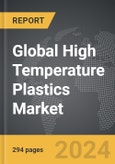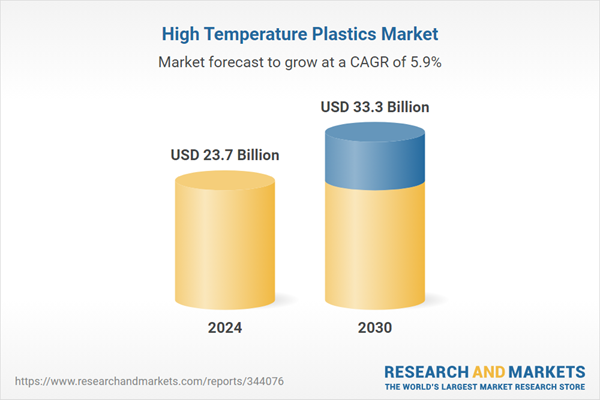Global High Temperature Plastics Market - Key Trends & Drivers Summarized
What Are High Temperature Plastics and Why Are They Important?
High temperature plastics are a class of polymers designed to withstand extreme heat, often above 150°C, without losing their mechanical and chemical properties. These materials are distinguished by their ability to perform under stress in aggressive environments, which makes them crucial for applications where ordinary plastics would fail. High temperature plastics include varieties such as polyetheretherketone (PEEK), polysulfone (PSU), and polyimides, each known for specific properties like resistance to thermal degradation, chemical attack, and mechanical wear. Industries such as aerospace, automotive, electronics, and industrial machinery rely on these materials for components that are exposed to high operational temperatures and harsh chemicals.How Are High Temperature Plastics Innovating Key Industries?
The integration of high temperature plastics has led to groundbreaking advancements in several key sectors. In the aerospace industry, these plastics are used to manufacture parts that reduce overall aircraft weight, thus enhancing fuel efficiency and reducing greenhouse gas emissions. Automotive applications include under-hood components which must endure high temperatures and chemical exposure while maintaining integrity and performance. Similarly, in the electronics industry, high temperature plastics are used in components like connectors, switches, and insulation materials, which are essential for ensuring reliability and functionality of devices at elevated temperatures. This widespread adoption is primarily due to the material's longevity, safety features, and performance in extreme conditions.What Trends Are Shaping the Demand for High Temperature Plastics?
The demand for high temperature plastics is heavily influenced by evolving industrial technologies and regulatory standards aimed at environmental sustainability. There is a growing shift towards lightweight and energy-efficient materials in automotive and aerospace sectors, driven by stricter emissions regulations globally. Additionally, the rapid advancement in electronic devices and the push for miniaturization require materials that can withstand higher operational temperatures and offer superior electrical insulation. The trend towards more durable and longer-lasting industrial machinery also supports the increased use of high temperature plastics in manufacturing sectors. Furthermore, the expansion of renewable energy systems, such as wind turbines, which require materials capable of enduring variable and harsh environmental conditions, underscores the growing reliance on these advanced polymers.What Drives the Growth of the High Temperature Plastics Market?
The growth in the high temperature plastics market is driven by several factors, including technological advancements, changing regulatory landscapes, and evolving consumer preferences. Innovations in polymer technology that enhance the heat resistance and mechanical strength of high temperature plastics are crucial in meeting the demands of high-performance applications. Regulatory pressures for lighter, more fuel-efficient vehicles promote the use of these plastics in the automotive sector. Similarly, the aerospace industry's ongoing pursuit of performance efficiency and safety continues to rely on lightweight, high-strength materials capable of withstanding extreme operating conditions. Consumer behavior also plays a significant role, as there is a growing demand for more durable and reliable electronic devices that operate safely under increased power and reduced size conditions.Report Scope
The report analyzes the High Temperature Plastics market, presented in terms of market value (USD). The analysis covers the key segments and geographic regions outlined below.- Segments: Product Type (Fluoropolymers, Polyimides, High Performance Polyamides, Polyketones, Polysulfones, Polyphenylene Sulfides, Liquid Crystal Polymers); End-Use (Electrical / Electronics, Automobile, Chemical / Industrial, Aerospace, Medical, Other End-Uses).
- Geographic Regions/Countries: World; United States; Canada; Japan; China; Europe (France; Germany; Italy; United Kingdom; and Rest of Europe); Asia-Pacific; Rest of World.
Key Insights:
- Market Growth: Understand the significant growth trajectory of the Fluoropolymers segment, which is expected to reach US$12.7 Billion by 2030 with a CAGR of 4.4%. The Polyimides segment is also set to grow at 6.3% CAGR over the analysis period.
- Regional Analysis: Gain insights into the U.S. market, valued at $6.5 Billion in 2024, and China, forecasted to grow at an impressive 5.6% CAGR to reach $5.3 Billion by 2030. Discover growth trends in other key regions, including Japan, Canada, Germany, and the Asia-Pacific.
Why You Should Buy This Report:
- Detailed Market Analysis: Access a thorough analysis of the Global High Temperature Plastics Market, covering all major geographic regions and market segments.
- Competitive Insights: Get an overview of the competitive landscape, including the market presence of major players across different geographies.
- Future Trends and Drivers: Understand the key trends and drivers shaping the future of the Global High Temperature Plastics Market.
- Actionable Insights: Benefit from actionable insights that can help you identify new revenue opportunities and make strategic business decisions.
Key Questions Answered:
- How is the Global High Temperature Plastics Market expected to evolve by 2030?
- What are the main drivers and restraints affecting the market?
- Which market segments will grow the most over the forecast period?
- How will market shares for different regions and segments change by 2030?
- Who are the leading players in the market, and what are their prospects?
Report Features:
- Comprehensive Market Data: Independent analysis of annual sales and market forecasts in US$ Million from 2024 to 2030.
- In-Depth Regional Analysis: Detailed insights into key markets, including the U.S., China, Japan, Canada, Europe, Asia-Pacific, Latin America, Middle East, and Africa.
- Company Profiles: Coverage of players such as 3M Company, Arkema Group, Asahi Glass Company Ltd., BASF SE, Chevron Phillips Chemical Company and more.
- Complimentary Updates: Receive free report updates for one year to keep you informed of the latest market developments.
Some of the 84 companies featured in this High Temperature Plastics market report include:
- 3M Company
- Arkema Group
- Asahi Glass Company Ltd.
- BASF SE
- Chevron Phillips Chemical Company
- China Lumena New Materials Corp.
- Covestro AG
- Daikin Industries Ltd.
- Dongyue Group Ltd.
- Dow Inc.
- DSM Engineering Plastics B.V.
- Evonik Industries AG
- Kuraray Co. Ltd.
- Mitsui Chemicals Inc.
- Performance Plastics Ltd.
- Polyplastics Co. Ltd.
- SABIC Innovative Plastics
- Sumitomo Chemical Co. Ltd.
- Toray Industries Inc.
This edition integrates the latest global trade and economic shifts into comprehensive market analysis. Key updates include:
- Tariff and Trade Impact: Insights into global tariff negotiations across 180+ countries, with analysis of supply chain turbulence, sourcing disruptions, and geographic realignment. Special focus on 2025 as a pivotal year for trade tensions, including updated perspectives on the Trump-era tariffs.
- Adjusted Forecasts and Analytics: Revised global and regional market forecasts through 2030, incorporating tariff effects, economic uncertainty, and structural changes in globalization. Includes historical analysis from 2015 to 2023.
- Strategic Market Dynamics: Evaluation of revised market prospects, regional outlooks, and key economic indicators such as population and urbanization trends.
- Innovation & Technology Trends: Latest developments in product and process innovation, emerging technologies, and key industry drivers shaping the competitive landscape.
- Competitive Intelligence: Updated global market share estimates for 2025, competitive positioning of major players (Strong/Active/Niche/Trivial), and refined focus on leading global brands and core players.
- Expert Insight & Commentary: Strategic analysis from economists, trade experts, and domain specialists to contextualize market shifts and identify emerging opportunities.
Table of Contents
Companies Mentioned (Partial List)
A selection of companies mentioned in this report includes, but is not limited to:
- 3M Company
- Arkema Group
- Asahi Glass Company Ltd.
- BASF SE
- Chevron Phillips Chemical Company
- China Lumena New Materials Corp.
- Covestro AG
- Daikin Industries Ltd.
- Dongyue Group Ltd.
- Dow Inc.
- DSM Engineering Plastics B.V.
- Evonik Industries AG
- Kuraray Co. Ltd.
- Mitsui Chemicals Inc.
- Performance Plastics Ltd.
- Polyplastics Co. Ltd.
- SABIC Innovative Plastics
- Sumitomo Chemical Co. Ltd.
- Toray Industries Inc.
Table Information
| Report Attribute | Details |
|---|---|
| No. of Pages | 294 |
| Published | December 2025 |
| Forecast Period | 2024 - 2030 |
| Estimated Market Value ( USD | $ 23.7 Billion |
| Forecasted Market Value ( USD | $ 33.3 Billion |
| Compound Annual Growth Rate | 5.9% |
| Regions Covered | Global |









